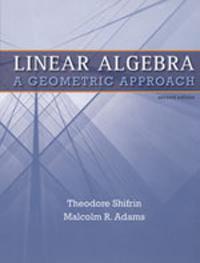| FindBook |
有 2 項符合
Linear Algebra: A Geometric Approach (Original)的圖書 |
| 圖書館借閱 |
| 國家圖書館 | 全國圖書書目資訊網 | 國立公共資訊圖書館 | 電子書服務平台 | MetaCat 跨館整合查詢 |
| 臺北市立圖書館 | 新北市立圖書館 | 基隆市公共圖書館 | 桃園市立圖書館 | 新竹縣公共圖書館 |
| 苗栗縣立圖書館 | 臺中市立圖書館 | 彰化縣公共圖書館 | 南投縣文化局 | 雲林縣公共圖書館 |
| 嘉義縣圖書館 | 臺南市立圖書館 | 高雄市立圖書館 | 屏東縣公共圖書館 | 宜蘭縣公共圖書館 |
| 花蓮縣文化局 | 臺東縣文化處 |
|
|
- 圖書簡介
Chapter 1. Vectors and Matrices
1. Vectors
2. Dot Product
3. Hyperplanes in Rn
4. Systems of Linear Equations and Gaussian Elimination
5. The Theory of Linear Systems
6. Some Applications
Chapter 2. Matrix Algebra
1. Matrix Operations
2. Linear Transformations: An Introduction
3. Inverse Matrices
4. Elementary Matrices: Rows get Equal Time
5. The Transpose
Chapter 3. Vector Spaces
1. Subspaces of Rn
2. The Four Fundamental Subspaces
3. Linear Independence and Basis
4. Dimension and Its Consequences
5. A Graphic Example
6. Abstract Vector Spaces
Chapter 4. Projections and Linear Transformations
1. Inconsistent Systems and Projection
2. Orthogonal Bases
3. The Matrix of a Linear Transformation and the Change-of-Basis Formula
4. Linear Transformations on Abstract Vector Spaces
Chapter 5. Determinants
1. Properties of Determinants
2. Cofactors and Cramer’s Rule
3. Signed Area in R2 and Signed Volume in R2
Chapter 6. Eigenvalues and Eigenvectors
1. The Characteristic Polynomial
2. Diagonalizability
3. Applications
4. The Spectral Theorem
Chapter 7. Further Topics
1. Complex Eigenvalues and Jordan Canonical Form
2. Computer Graphics and Geometry
3. Matrix Exponentials and Differential Equations
For Further Reading
Answers to Selected Exercises
List of Blue Boxes
Index - 目次
Linear Algebra: A Geometric Approach, Second Edition, presents the standard computational aspects of linear algebra and includes a variety of intriguing interesting applications that would be interesting to motivate science and engineering students, as well as help mathematics students make the transition to more abstract advanced courses. The text guides students on how to think about mathematical concepts and write rigorous mathematical arguments.Geometry is introduced early, using vector algebra to analytic geometry in the first section and dot product in the second.Concepts and understanding is emphasized, doing proofs in text and providing plenty of exercises. To aid the student in adjusting to the mathematical rigor, blue boxes are provided which discuss matters of logic and proof technique or advice on formulating problem-solving strategies.Rotations, reflections, and projections are used as a first brush with the notion of linear transformation when introducing matrix multiplication. Linear transformations are then treated in concert with the discussion of projections. Thus, the change-of-basis formula is motivated by starting with a coordinate system in which a geometrically defined linear transformation is clearly understood and asking for its standard matrix.Orthogonal complements are emphasized, with their role in finding a homogenous system of linear equations that defines a given subspace of Rn.
|











